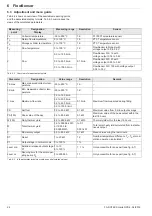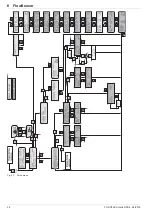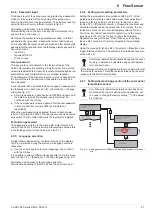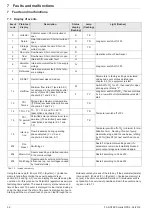
20
FA ROTEX Solaris RPS4 -
04/2016
6
x
FlowSensor
6.2 Operating mode of control system
6.2.1 Pump operation
The solar system is operated fully-automatically all year round
without the need for manual intervention. The speed-regulated
pump operation is controlled by the Solaris R4 regulator. The op-
erating and display elements are shown in fig. 6-1.
Criterion for actuation:
– Pump operation depends on the continuously measured tem-
perature difference between the solar panel (T
K
) and the
return flow temperature (T
R
) and a comparison with the set
value of the parameter [Delta T on].
The solar operating pump P
S
switches on, if the temperature
difference (= T
K
– T
R
) exceeds rhe value set in the parameter
[Delta T on] (e.g. return flow temperature = 40°C and
[Delta T on] = 15 K; solar panel temperature > 55°C).
Criteria for switching off:
– The solar operating pump P
S
switches off if the temperature
difference falls below the value set on the parameter
[Delta T off].
1. Possibility:
Normal switch-off if the "filling time" (Parame-
ter [time P2]) has expired and the temperature difference
between the flow and return temperatures has reached the
switch-off condition (T
V
– T
R
< [Delta T off]).
2. Possibility:
Rapid switch-off if the solar panel cools off too
quickly within the "filling time" (Parameter [time P2])
(T
K
– T
R
< [Delta T off]).
– Achieving the maximum storage tank temperature set via
parameter [TS max] (T
S
light flashes). In this case, restarting
the solar operating pump P
S
is only possible if the storage
tank temperature has fallen by more than 2 K.
– Achieving the maximum permissible panel temperature set
via the parameter [TK permitted] (T
K
light flashes). In this
case, restarting the solar operating pump P
S
is only possible
if the solar panel temperature has fallen below the parameter
value [TK permitted] by more than 2 K.
– Faulty FlowSensor.
6.2.2 Booster function for high solar panel
temperatures
Above a solar panel temperature of [TK max], the output of the
solar operating pump P
S
is operated at max. output.
Î
This increases the system pressure as well as the flow
quantity, which enables more heat to be stored within a
shorter time.
The booster temperature can be changed by a heating expert
with the parameter [TK max]. This increase in output is switched
off again automatically if the booster temperature falls by 5 K.
6.2.3 Start optimisation
Start optimisation prevents too frequent cycling and reduces the
power consumption. This is a self-learning function. Start optimi-
sation is activated in the factory.
6.2.4 Switch-on block functions
The switch-on block functions prevent:
– switching on again if, because of reaching the set maximum
storage tank temperature [TS max] the solar system has
been automatically switched off (T
S
light flashes).
– pump operation with activated "intensified frost protection
function" (star symbol flashes in the display - see
section 6.2.11).
– pump operation, if the solar panel temperature exceeds the
adjustable value set by the heating expert by parameter
[TK permitted] (T
K
light flashes).
After switching off the solar operating pump P
S
as a result of the
maximum storage tank temperature, continuing impingement of
the sun's rays on the solar panel can cause temperatures of over
100°C. If the storage tank temperature falls below the release
temperature ([TS max] – 2 K), (e.g. by the removal of hot water),
the solar operating pump P
S
is only switched on again if the tem-
perature at the solar panel falls below the value set with the pa-
rameter [TK permitted] for the restart protection temperature by
2 K.
The function blocking time ensures that the solar operating pump
P
S
is only released again, after the occurrence of a switch-off
condition, after expiry of the blocking time set in the parameter
[time SP] (0 – 600 secs.).
This means:
– the cycling of the solar system can be minimised.
– the solar panel can achieve a higher temperature.
– when filling the solar system, the flow temperature does not
fall below the switch-off condition and the system regulates
itself more quickly.
Due to continual improvements for the optimum use of
the system, the Solaris R4 has been equipped with an
update function. Consequently some of the functions
described in this chapter are only applicable to certain
software versions. These functions are separately identified by
symbols.
Software updates to the Solaris R4 regulator must only be done
by the ROTEX service technician.
The power switch completely disconnects the
Solaris R4 regulator from the mains voltage. Switching
of the mains switch takes more effort in pushing the but-
ton than is required for actuating the operating buttons.
If there is active frost protection (T
K
<0°C within the last
24 h) there will be no rapid switch-off. The solar operat-
ing pump P
S
is operated for an extended period, so that
the connecting lines are heated up to such a tempera-
ture that does not permit the formation of ice plugs.
In this case, however, a considerably higher solar panel temper-
ature must be achieved before the solar operating pump P
S
switches on.
If the solar operating pump P
S
is switched on at solar
panel temperatures over 100°C (T
K
perm > 100°C), the
return water vapourises as soon as it reaches the solar
panel. Similarly, a slightly increased consumption of
cylinder water due to escaping steam is a normal operating con-
dition.
The water vapour escapes in a depressurised manner into the
soalr storage tank in a correctly installed solar sysyem, where it
condenses again to a large extent. A slight increase in the con-
sumption of buffer water, caused by the escaping unpressurized
water vapour, is a normal operating condition.






























